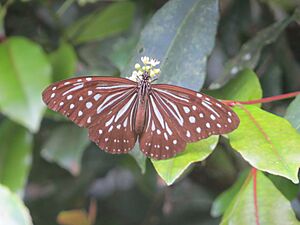Nilgiri tiger facts for kids
Quick facts for kids Nilgiri tiger |
|
|---|---|
 |
|
| Conservation status | |
| Scientific classification | |
| Synonyms | |
|
The Nilgiri tiger (scientific name: Parantica nilgiriensis) is a beautiful butterfly. You can find it in the Western Ghats of India. It lives in the southern part of this mountain range.
This butterfly is part of the Nymphalidae family, also known as brush-footed butterflies. It belongs to a group called Danainae, which includes many well-known butterflies.
The Nilgiri tiger butterfly is special because it only lives in the high mountains of southern India. It prefers cool shola forests, usually above 1500 meters (about 4,900 feet) high. Sometimes, you might even spot it in gardens looking for flowers!
Sadly, this butterfly is considered near-threatened. This means its numbers have been going down. One big reason is that its forest homes are being lost. Many areas are now used for growing tea.
The Nilgiri tiger looks a lot like two other butterflies. One is Parantica fumata, which lives in Sri Lanka. The other is Parantica aglea, a common butterfly found in India and other parts of Southeast Asia.
Contents
Butterfly Behavior
Butterflies have interesting ways of living. The Nilgiri tiger shows some unique behaviors, especially when it comes to laying eggs and flying around.
Egg-Laying Habits
When a female Nilgiri tiger butterfly is ready to lay eggs, she flies around healthy plants. She looks for the perfect fresh leaves. Once she finds one, she lands on the edge.
She uses her front legs to hold on. While gently flapping her wings, she bends her body. She then lays a single egg on the underside of the leaf. She might lay several eggs in one go, but usually keeps them a little bit apart.
Adult Butterfly Life
The Nilgiri tiger butterfly flies quickly and sometimes in a zig-zag pattern. You might see many of them gathered on flowering trees. They especially like plants like Lantana in open areas of the forest.
These butterflies also enjoy sipping moisture. They often do this from wet spots on forest banks or near clear streams. Other mountain butterflies do this too!
Host Plants
The caterpillars of the Nilgiri tiger butterfly need specific plants to eat. Their favorite food plants are Tylophora tenuis and Tylophora indica.
Interestingly, they do not eat Calotropis plants. This is different from their close relative, Parantica aglea, which does feed on Calotropis.
What Does the Nilgiri Tiger Look Like?
The Nilgiri tiger butterfly is quite striking. Both males and females are a dull brownish-black color. They have pretty, dirty-white markings and spots on their wings.
Wings
Their wingspan is usually between 80 and 90 millimeters (about 3 to 3.5 inches). The white markings on their wings are narrower and smaller compared to similar butterflies. The dark background color covers most of their wings.
The male butterfly has a special patch of scent scales on its hindwing. These scales help it attract a mate.
Eggs
The eggs of the Nilgiri tiger butterfly are white and shiny. They are shaped like a dome and have small ridges on them.
Life Cycle: From Larva to Pupa
The Nilgiri tiger butterfly goes through several stages in its life. This process is called metamorphosis.
Larva (Caterpillar)
The eggs hatch after about four or five days. The tiny caterpillar that emerges is pearly white. It has a noticeable black head and dark gray legs.
As the caterpillar grows, it changes. It starts to show a purplish body color. White, oval, and round spots appear, similar to what you see on a fully grown caterpillar. These spots form four rows along its body.
The spots in the side rows and on the first and last few body parts turn yellow. The caterpillar also develops small tentacles. There's a pair on its second body part and small bumps on its twelfth part.
By the time it's fully grown, the caterpillar is about 6 to 7 centimeters (about 2.4 to 2.8 inches) long. Its tentacles become long and thin and are black. All the white spots turn yellow, standing out against its dark purple body. The caterpillar takes about 14 to 15 days to grow before it's ready to change into a pupa.
Caterpillar Behavior
Young caterpillars (in their first and second stages) have a cool trick. If they feel scared, they can "silk dive." This means they simply drop down and hang from a silk thread they make! It's a way to escape from predators. This behavior is rare among butterflies in the danaid group. As they get older, they stop doing this.
Pupa
After growing, the caterpillar changes into a pupa. The pupa is green with shiny silver and black spots. It hangs freely, usually from the underside of a leaf or a small branch. It looks very similar to the pupa of the plain tiger butterfly.
The pupa stage lasts about 11 to 12 days. Just before the adult butterfly emerges, you can start to see the wing patterns through the pupa's skin. The pupa turns very dark, almost black, the night before the butterfly hatches.
Where Does It Live?
The Nilgiri tiger butterfly lives in southern India. Its main homes are in the Nilgiris (Nilgiri Hills), Malabar, and Travancore hills. These areas are all part of the Western Ghats.
See also
- Danainae
- Nymphalidae
- List of butterflies of India
- List of butterflies of India (Nymphalidae)


